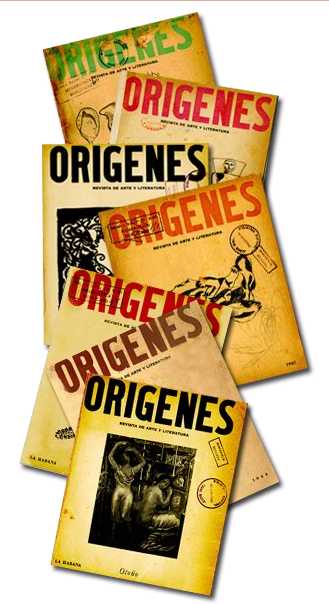4.1.2.1 The Orígenes Magazine (1944 – 1956)

“Origins was one of the few real things in a world of phantasmagoria.”
Eliseo Diego
The magazine Orígenes first appeared in the spring of 1944. It was then that its editors would define the publication’s purpose, an aesthetic framework compatible with all the beliefs expressed in the cultural landscape of the time, but which at the same time surpassed previous formulations of the literary phenomenon in the context of the nation:
“ORÍGENES isn’t interested in formulating a program, but rather in launching the arrows of its own wake. Since we don’t change with the seasons, we don’t have to justify a chameleon’s skin in lengthy arguments. We’re not interested in superficial mutations, but rather in taking possession of being. We want to situate ourselves close to those forces of creation, of all strong birth, where we must seek the purity or impurity, the quality or disqualification of all art.”
The Origenist universe would, however, have numerous publications as a precedent, through which a collective spirit took shape that would reach sufficient maturity by the aforementioned date of 1944. These include “Verbum,” whose first issue had been published in 1937; “Espuela de Plata,” from 1939 to 1941; “Clavileño,” from 1941 to 1943; and “Nadie Parecer,” from 1942 to 1944; as well as the magazine “Luz,” the fruit of the school years of Eliseo Diego and Cintio Vitier.
Orígenes was published quarterly, and its four annual appearances specifically corresponded to the seasons. José Lezama Lima remained as director, while José Rodríguez Feo remained co-director. Due to a disagreement between the two, the organization split in 1956, and the organization dissolved that same year, leaving lasting marks on the spiritual fabric of the nation.
The magazine’s conception united life—nation—and literature, both in its search for transcendent history and in its effort to break away from the banalization that threatened the republican cultural landscape. Although of uneven aesthetic quality, the works of the leading poets included in its pages demonstrate this deep-rooted Cuban identity and the acceptance of culture as the fulfillment of existence, a purpose for an era lacking it due to political and social frustration.
In addition to the members of Orígenes, works by many other prestigious Cuban writers were published, including Alejo Carpentier, Samuel Feijóo, Roberto Fernández Retamar, Fayad Jamís, Pablo Armando Fernández, Eugenio Florit, Emilio Ballagas, Rolando Escardó, Dulce María Loynaz, and others.
From the international sphere, texts by Octavio Paz, Juan Ramón Jiménez, María Zambrano, TS Elliot, Jorge Guillén, Paul Valéry, Luis Cernuda, Rainer María Rilke, Aimé Cesaire and Vicente Aleixander, among others, stand out.
The publication of Orígenes, in addition to the laudable rescue of the rich cultural tradition on which the nation is built, has been integrated into the flow of the island’s culture as one of its pinnacles, a reference point for the republican era and the entire 20th century in Cuba, fostering an atmosphere that has endured after the triumph of the Revolution and to which many of today’s publications owe their origins.
According to Iván González: “The magazine Orígenes, united with the nation’s innermost self, gradually reintegrated the fragmented universe, enriching the cultural environment, maturing its gestations for future harvests. From secular ruins it emerged converted into light, and the lethargy that apathy sought to impose on it became anonymous because words have no silence. And what is Orígenes but a great promise, a crucible of nascent, unknown Cubanness?”








